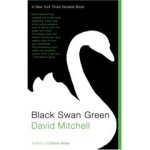Black Swan Green is populated with a myriad of pop-culture references. There’s Lord of the Rings and The Chronicles of Thomas Covenant.  Asteroids, space invaders and Rubik’s Cub. King Kong and the Millenium Falcon. Levis and the Sony Walkman. And then there’s music. With the exception of A Flock of Seagulls, almost every other poplular band in the early 1980s makes an appearance in Black Swan Green—from Neil Young and the Scorpions, through the Rolling Stones and Fleetwood Mac, to Def Leppard, Scorpions, and my beloved Meatloaf, and beyond. Here’s an observation, and I’d like to get your 2¢. I don’t think Mitchell’s musical references work—and not through any fault of his own. I think it’s a limitation of storytelling. It’s one thing to listen to music, which has an incomparable power to recover lost time. But it’s quite another to drop a band’s name in a story, even if it is the crazy hot and pouty-lipped Blondie. It simply doesn’t tap emotional resonances, at least not in the same way as saying “Atari,” “MTV,” “Watership Down, “Adidas” or “Thatcher.” Right?
Asteroids, space invaders and Rubik’s Cub. King Kong and the Millenium Falcon. Levis and the Sony Walkman. And then there’s music. With the exception of A Flock of Seagulls, almost every other poplular band in the early 1980s makes an appearance in Black Swan Green—from Neil Young and the Scorpions, through the Rolling Stones and Fleetwood Mac, to Def Leppard, Scorpions, and my beloved Meatloaf, and beyond. Here’s an observation, and I’d like to get your 2¢. I don’t think Mitchell’s musical references work—and not through any fault of his own. I think it’s a limitation of storytelling. It’s one thing to listen to music, which has an incomparable power to recover lost time. But it’s quite another to drop a band’s name in a story, even if it is the crazy hot and pouty-lipped Blondie. It simply doesn’t tap emotional resonances, at least not in the same way as saying “Atari,” “MTV,” “Watership Down, “Adidas” or “Thatcher.” Right?
Black Swan Green (2)
May 3, 2010Black Swan Green
April 29, 2010In works ranging from ghostwritten to Cloud Atlas, David Mitchell has shown that he’s a fearless and an eminently capable writer. His formal inventiveness and experimentation with styles, points of view, and non-linear plot structures yields a richly conceptual fiction.
 In Black Swan Green, however, Mitchell eschews post-modern pyrotechnics in favor of a simple narrative style. Set in the village of Black Swan Green in Worcestershire, England in the early 1980s, we follow a year in the life of Jason Taylor, 13-year old English chap, who suffers from a stammer he calls Hangman and writes poetry under the nom de plume Eliot Bolivar. Like many adolescents, Jason struggles with mortality, adult hypocrisy, and the pain of being different.
In Black Swan Green, however, Mitchell eschews post-modern pyrotechnics in favor of a simple narrative style. Set in the village of Black Swan Green in Worcestershire, England in the early 1980s, we follow a year in the life of Jason Taylor, 13-year old English chap, who suffers from a stammer he calls Hangman and writes poetry under the nom de plume Eliot Bolivar. Like many adolescents, Jason struggles with mortality, adult hypocrisy, and the pain of being different.
This narrative change of pace is a refreshing departure for Mitchell. You’ll almost look in vain for physical descriptions, for instance, in Cloud Atlas, where, if you are as vigilant as a bird of prey, you might notice that Rufus Sixsmith wears a gabardine coat. Like Saramago, with whom he otherwise has little in common, Mitchell has a tendency to soar off the page into abstract realms. But with Black Swan Green, he plunges headlong into the bright, redolent world of sensory details.
Jason’s sister’s boyfriend, for instance, has … “exploding red hair, sooty freckles, and a bouncy walk. He wore a peach shirt under a baggy indigo sweater, black drainpipes, one of those studded belts that sags loose off your hips, and winkle-pickers with white tube socks…” Luscious mangoes taste like “perfumed peaches, bruised roses” and beef “like deep-sea phlegm,” and the kitchen smells of “lavender and bacon rinds.”
As the vibrant world of Black Swan Green unfolds, we learn that Jason is a verbifyer extraordinaire—”chuntering,” “clackering,” and “snaffling,” as well as “juddering,” “knackering,” and “elasticking”—who, in true Mitchellian fashion, is also profoundly sensitive to the great incongruities of the world:
I dip my fountain pen into a pot of ink, and a Wessex helicopter crashes into a glacier on South Georgia. I line up my protractor on an angle in my Maths book and a Sidewinder missile locks onto a Mirage III. I draw a circle with my compass and a Welsh Guard stands up in a patch of burning gorse and gets a bullet through the eye.
Mitchell’s novel is bursting with cinematographic scenes. Like the time when Jason is injured and finds himself in the foreboding House in the Woods, being tended to by an old, mysterious woman who is haunted by the memory of her dead brother. Or the almost-kiss with tomboy Dawn Madden who has eyes of dark honey and a throat of white chocolate.
But my favorite scene is Jason’s mad dash through neighborhood backyards to gain membership into a secret society called Spooks. He clambers over a fence, sprints through an abandoned yard overgrown with weeds, then an even dodgier lot with two fat ladies watching TV, then Mr. Broadwas’ yard with the sprinklers swsss-swwss-swwwsssing away, then “a concrete meringue” with ornaments, gravel, and gnomes, then a tight-rope walk across a 10-foot high fence hovering over a greenhouse, and finally through a backyard adorned with a trellis of roses and a family playing Twister in their cottage. The scene combines the adventure of childhood with the magic of prose fiction.
After all, storytelling is a virtual romp through distant or neighboring yards.



 Posted by Kevin Neilson
Posted by Kevin Neilson 